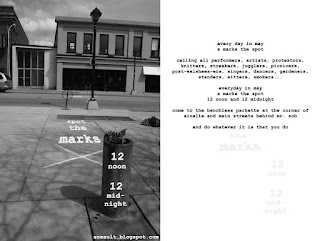Hi Sarah. It's great to meet you (assuming I didn't bump into you in the crowd at SciBarCamp). As Mark said, I'm working on a WCC piece regarding how people re-mix urban spaces. I'm trying to think of the city as a text, rather than as a machine or a body. Toronto's recent brouhaha about bike lanes brought this home for me, because the lanes involve a literal re-writing of the street's surface, turning the road into a palimpsest of sorts. Am I way off-base in that reading of the city? And can you think of other examples of re-mixed spaces? Are there any other thinkers (besides Bruce Sterling) who think of built environments in this way? Thanks, Madelinehi madeline this sounds like an interesting article! i think that the idea of city as text is a bit outdated in the field of architecture...the discourse at the moment is more direct: the city fabulous metaphor in itself and doesn't need an additional metaphor to describe it. there's a belief that the meaning of form in architecture is irrelevant, and that people will appropriate and use any space however they desire. rem koolhaas' "delirious new york" is the seminal text in this way of thinking. this has led architects to focus more on material research and innovation, rather than social experimentation (not me, of course). the idea of the palimpsest was very popular in architecture in the 80s and 90s. that was an era of architectural theory, based on deleuze and guattari's writings on literary theory, which was very focused on destabilizing the dominant regimes - social and political - through architectural form. this was appropriate at the time (before the fall of the berlin wall) but not at this present moment of globalization and economic instability. that being said, one of my favorite theorists, robert venturi, is from that era and uses semiotics to analyze architecture and urbanism. the difference, i think, is he looked for new ways architecture expressed meaning, rather than dismissing the idea that architecture can/should affect social change. look at "learning from las vegas" by robert venturi and denise scott-brown for a great analysis of the way commercial architecture "speaks" to the citzens of and visitors to las vegas. (one of the arguments in my thesis is that he developed a language that described the elements of an "emergent" system, the city, and that his methods should be used now as a basis for a new social/semiological language for architectural design which treats the group of users of an urban building as an adaptive emergent system) other architects/writers you may want to look at are jan gehl, who talks about "streets for people" (and is speaking at the design exchange next wednesday), and teddy cruz, who's work in with immigrant and low income populations in sandiego and tijuana is empowering and inspiring! there are increasingly urban "movements", which often inlcude architects, which simply appropriate space in the city: Banksy (a graffiti artist from the UK), guerrilla gardening (and bike lanes and park benches), the white/ghost bicycles (monuments of urban cyclist deaths), and knitta please (knitted "graffiti"). hope this helps s
Evening lighting
-
Had an interesting walk tonight in my hometown of Waterloo, and I reminded
myself that perspective, lighting and the right architectural gesture
placed i...
11 years ago








































